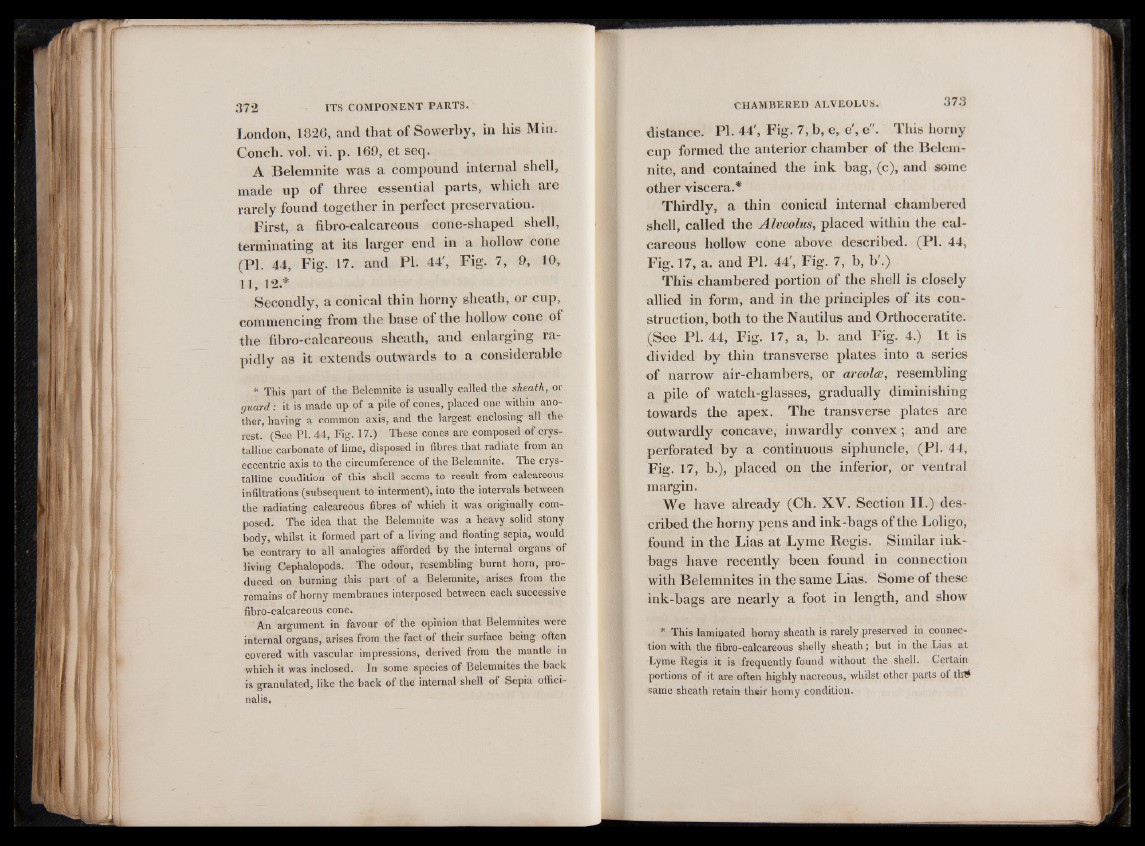
London, 1826, and that of Sowerby, in his Min.
Conch, vol. vi. p. 169, et seq.
A Belemnite was a compound internal shell,
made up of three essential parts, which are
rarely found together in perfect preservation.
First, a fibro-calcareous cone-shaped shell,
terminating at its larger end in a hollow cone
(PI. 44, Fig. 17. and PI. 44', Fig. 7, 9, 10,
11, 12.*
Secondly, a conical thin horny sheath, or cup,
commencing from the base of the hollow cone of
the fibro-calcareous sheath, and enlarging rapidly
as it extends outwards to a considerable
* This part of the Belemnite is usually called the sheath, or
guard: it is made up of a pile of cones, placed one within another,
having a common axis, and the largest enclosing all the
rest. (See PI. 44, Fig. $7.) These cones are composed of crystalline
carbonate of lime, disposed in fibres that radiate from an
eccentric axis to the circumference of the Belemnite. The crystalline
condition of this shell seems to result from calcareous
infiltrations (subsequent to interment), into the intervals between
the radiating calcareous fibres of which it was originally composed.
The idea that the Belemnite was a heavy solid stony
body, whilst it formed part of a living and floating sepia, would
be contrary to all analogies afforded by the internal organs of
living Cephalopods. The odour, resembling burnt horn, produced
on burning this part of a Belemnite, arises from the
remains of horny membranes interposed between each successive
fibro-calcareous cone.
An argument in favour of the opinion that Belemnites were
internal organs, arises from the fact of their surface being often
covered with vascular impressions, derived from the mantle in
which it was inclosed. In some species of Belemnites the back
is granulated, like the back of the internal shell of Sepia officinalis.
distance. PL 44', Fig. 7, b, e, e', e". This horny
cup formed the anterior chamber of the Belemnite,
and contained the ink bag, (c), and some
other viscera.*
Thirdly, a thin conical internal chambered
shell, called the Alveolus, placed within the calcareous
hollow cone above described. (PI. 44,
Fig. 17, a. and PI. 44', Fig. 7, b, b'.)
This chambered portion of the shell is closely
allied in form, and in the principles of its construction,
both to the Nautilus and Orthoceratite.
(See PI. 44, Fig. 17, a, b- and Fig. 4.) It is
divided by thin transverse plates into a series
of narrow air-chambers, or areolce, resembling
a pile of watch-glasses, gradually diminishing
towards the apex. The transverse plates are
outwardly concave, inwardly convex; and are
perforated by a continuous siphuncle, (PL 44,
Fig. 17, b.), placed on the inferior, or ventral
margin.
We have already (Ch. XV. Section II.) described
the horny pens and ink-bags of the Loligo,
found in the Lias at Lyme Regis. Similar ink-
bags have recently been found in connection
with Belemnites in the same Lias. Some of these
ink-bags are nearly a foot in length, and show
* This laminated homy sheath is rarely preserved in connection
with the fibro-calcareous shelly sheath; but in the Lias at
Lyme Regis it is frequently found without the shell. Certain
portions of it are often highly nacreous, whilst other parts of th#
same sheath retain their horny condition.